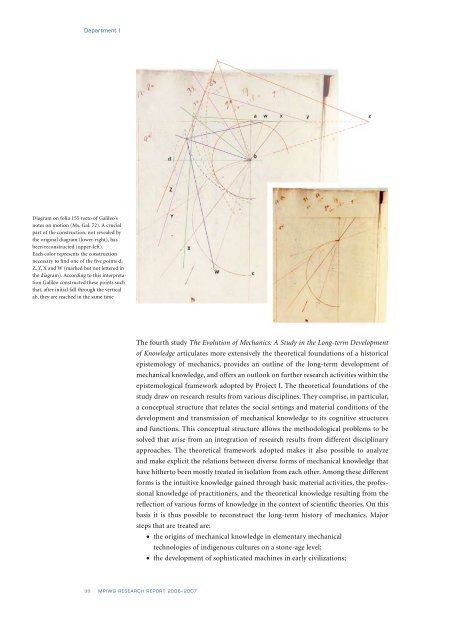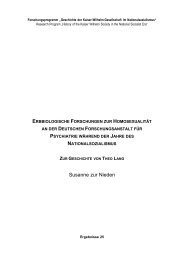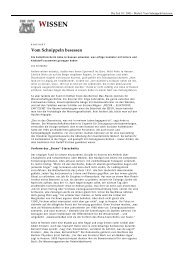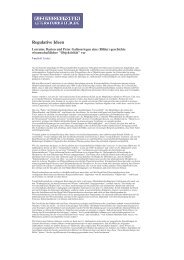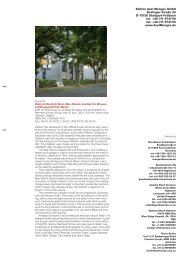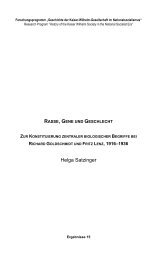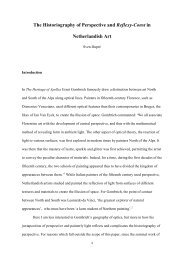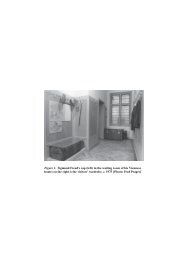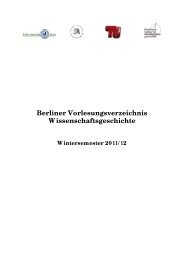Max Planck Institute for the History of Science
Max Planck Institute for the History of Science
Max Planck Institute for the History of Science
Create successful ePaper yourself
Turn your PDF publications into a flip-book with our unique Google optimized e-Paper software.
Department I<br />
Diagram on folio 155 recto <strong>of</strong> Galileo’s<br />
notes on motion (Ms. Gal. 72). A crucial<br />
part <strong>of</strong> <strong>the</strong> construction, not revealed by<br />
<strong>the</strong> original diagram (lower-right), has<br />
been reconstructed (upper-left).<br />
Each color represents <strong>the</strong> construction<br />
necessary to find one <strong>of</strong> <strong>the</strong> five points d,<br />
Z, Y, X and W (marked but not lettered in<br />
<strong>the</strong> diagram). According to this interpretation<br />
Galileo constructed <strong>the</strong>se points such<br />
that, after initial fall through <strong>the</strong> vertical<br />
ab, <strong>the</strong>y are reached in <strong>the</strong> same time<br />
The fourth study The Evolution <strong>of</strong> Mechanics: A Study in <strong>the</strong> Long-term Development<br />
<strong>of</strong> Knowledge articulates more extensively <strong>the</strong> <strong>the</strong>oretical foundations <strong>of</strong> a historical<br />
epistemology <strong>of</strong> mechanics, provides an outline <strong>of</strong> <strong>the</strong> long-term development <strong>of</strong><br />
mechanical knowledge, and <strong>of</strong>fers an outlook on fur<strong>the</strong>r research activities within <strong>the</strong><br />
epistemological framework adopted by Project I. The <strong>the</strong>oretical foundations <strong>of</strong> <strong>the</strong><br />
study draw on research results from various disciplines. They comprise, in particular,<br />
a conceptual structure that relates <strong>the</strong> social settings and material conditions <strong>of</strong> <strong>the</strong><br />
development and transmission <strong>of</strong> mechanical knowledge to its cognitive structures<br />
and functions. This conceptual structure allows <strong>the</strong> methodological problems to be<br />
solved that arise from an integration <strong>of</strong> research results from different disciplinary<br />
approaches. The <strong>the</strong>oretical framework adopted makes it also possible to analyze<br />
and make explicit <strong>the</strong> relations between diverse <strong>for</strong>ms <strong>of</strong> mechanical knowledge that<br />
have hi<strong>the</strong>rto been mostly treated in isolation from each o<strong>the</strong>r. Among <strong>the</strong>se different<br />
<strong>for</strong>ms is <strong>the</strong> intuitive knowledge gained through basic material activities, <strong>the</strong> pr<strong>of</strong>es-<br />
sional knowledge <strong>of</strong> practitioners, and <strong>the</strong> <strong>the</strong>oretical knowledge resulting from <strong>the</strong><br />
reflection <strong>of</strong> various <strong>for</strong>ms <strong>of</strong> knowledge in <strong>the</strong> context <strong>of</strong> scientific <strong>the</strong>ories. On this<br />
basis it is thus possible to reconstruct <strong>the</strong> long-term history <strong>of</strong> mechanics. Major<br />
steps that are treated are:<br />
30 MPIWG ReseaRch RePoRt 2006– 2007<br />
· <strong>the</strong> origins <strong>of</strong> mechanical knowledge in elementary mechanical<br />
technologies <strong>of</strong> indigenous cultures on a stone-age level;<br />
· <strong>the</strong> development <strong>of</strong> sophisticated machines in early civilizations;


